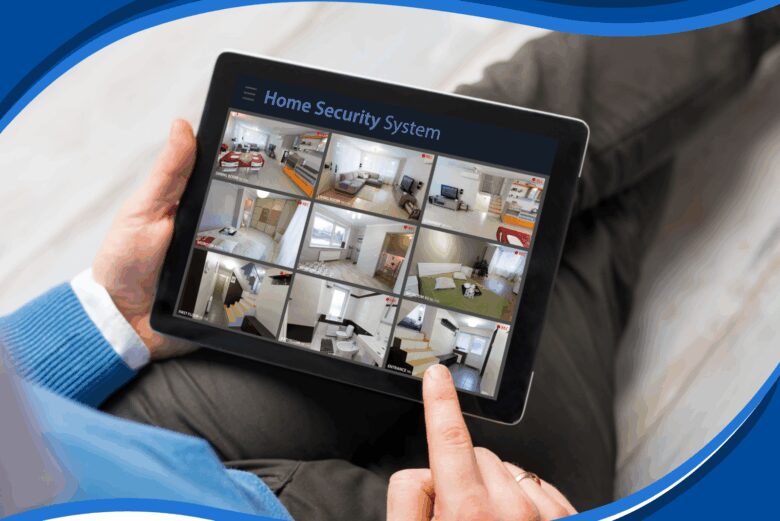Parks Associates conducted a fascinating consumer study last year, a study that showed the majority of internet households in the U.S. were comfortable with the idea of DIY home security monitoring. Additionally, the study showed that DIY monitoring has grown more popular since the COVID pandemic.
Digging into the possible reasons is an interesting study in anthropology. Human behavior is curious enough when all things are going well. But throw in something like the COVID pandemic and major alterations in behavior can be expected. That is exactly what Parks Associates believe has happened with home security – and monitoring in particular.
What the Study Found

Source: pcmag.com
Parks Associates surveyed some 8,000 internet households in the U.S. to determine how people felt about DIY home security. It turns out that 60% of those with home security systems installed are comfortable with self-monitoring. They believe monitoring their own systems keeps them just as safe as professional monitoring.
The study also revealed that consumers “view self-monitoring as a way to be notified of what’s going on in their homes.” It is not clear how they respond to security alerts, but common sense dictates they would respond accordingly.
Parks researchers say that self-monitoring really took off when the COVID pandemic hit. That makes sense. Technicians could not get inside consumer homes to install security equipment. That led more people to install DIY systems. And with increased DIY sales came a higher prevalence of DIY monitoring.
Professional Installation Is Still Popular
The Parks Associates study shows that professional monitoring has lost some of its luster. Among survey respondents who reported having quit professional service in favor of self-monitoring, the biggest reason was cost. Consumers expressed a desire to save money on monthly monitoring by doing it themselves.
That said, professional installation is still a popular option. According to Parks, professionally installed home security is nearly back to pre-pandemic levels. Consumers may not be choosing professional monitoring as frequently as they used to, but they still have an appetite for professional installation.
That is good for companies like Vivint Home Security. As the nation’s number two home security provider, Vivint insists on installing everything it sells. Professional installation guarantees that every device works as it is supposed to. It guarantees that customers are getting maximum protection.

vivint home security
A Lot Has Changed Over the Years
There could be another contributing factor to the rise of DIY security monitoring. People could be more confident in self-monitoring because technology is so much better in the digital era. Stop and think about what things used to be like.
In the 1970s and 80s, self-monitoring was virtually unheard of. There was no practical way to monitor one’s home security system while away. The technology just didn’t exist at a price most people could afford. Therefore, homeowners either paid for professional monitoring or did not worry about it at all.
Wireless technology began to emerge in the late 1990s. But back then, both the internet and cell phones were still quite immature. Self-monitoring remained impractical for all but the wealthiest consumers. But look at where we are today.
Effective and Affordable Technology
The modern home security environment is dominated by effective and affordable technology. Anyone can purchase a sub-$50 wireless camera and monitor it with a mobile app. Consumers do not get a whole lot of features at that price, but they do get live streaming video that they can check any time of the night or day.
Consumers insisting on DIY home security can invest in entire systems from brands like SimpliSafe and Ring. And of course, the three biggest names in tech – Google, Amazon, and Apple – all have their own smart home and home security ecosystems.
Third-party device manufacturers know where the money is. They make sure their devices are compatible with all the major ecosystems. That way, they get maximum exposure among the largest number of consumers.
Even Open-Source Works Today
Home security technology is so mature in the 2020s that even open-source solutions are on the table. That was not the case a decade ago. Back then, there were only one or two options – and they were still being developed. Many more options exist today. Most of them have reached stable maturity.
An open-source platform allows the homeowner to build an entire home security and automation system from scratch, using a variety of third-party components. Nearly all of the open-source platforms support mainstream brands like Kasa, D-Link, Tuya, Samsung, etc.
Going open source does require a bit of knowledge and a willingness to learn, but it is entirely possible. We could not say that 10 years ago.
Professional Home Security Isn’t Going Anywhere

modern home security
Fans of professional home security do not need to worry about the rise of DIY. Professional installation and monitoring are not going anywhere. Why? Because there will always be that segment of the buying public that isn’t interested in putting in the work or learning new things. They would rather pay someone else to install and monitor their equipment.
This same group of people is also willing to pay for the convenience. They add the cost of professional monitoring to their monthly budgets, paying it just as they do their utility bills, phone builds, and internet access.
Those who prefer the DIY option have every reason to be positive as well. The market is strong enough to encourage both major DIY brands and a slew of third-party device makers willing to support those brands. There is definitely no shortage of options for the DIY crowd.
To me, that’s the beauty of modern home security and home automation. We have so many more choices today than we did just a few years ago. And compared to first generation home security systems, what we have today is far superior.
If you are a fan of DIY home security, you are not alone. The COVID pandemic gave DIY home security a big boost, a boost that continues even today. At least something good came out of the pandemic.




